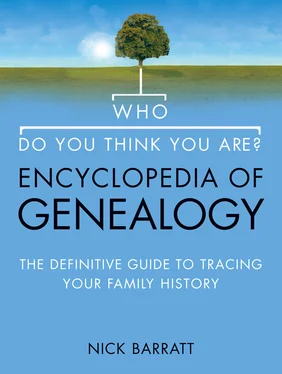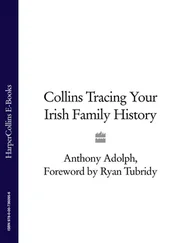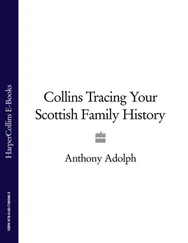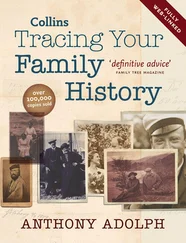• Signature, description and residence of the informant: This can also be a useful piece of genealogical information as sometimes it would be family members who would register the deaths. However, after 1874 the law changed and it was compulsory to have a doctor’s certificate before a death certificate could be issued, and hence doctors would sometimes appear as the informants.
• When registered: The date the death was registered, the legal requirement being five days after the death of the person. However, if a coroner was involved, there may well be a considerable delay in registration.
• Signature of registrar: The signature of the local registrar.
Death certificates
Whilst pursuing Bill Oddie’s family tree, his parents’ marriage certificate revealed that both their fathers had died by the time the couple married in 1938. This information was used to search for the death certificate (below, left) of Wilkinson Oddie, Bill’s grandfather. Starting with 1938, a search was made backwards in time, and an entry was found in 1927 for Wilkinson Oddie, aged 62, whose death was registered in the Oldham district. This important biographical information made it easy to look for his birth certificate, which was found in Rochdale in 1864. Given Bill’s father Harry was born in 1910, Wilkinson would have been 46 at the time of his son’s birth, which seemed quite old. Having found his birth and death certificate, a search was made for Wilkinson’s marriage certificate prior to 1910, which was found registered in Rochdale in 1907, to Emily Hawksworth. On the certificate, Wilkinson’s age was confirmed at 42 and his marital status was listed as widower. Clearly, further stories remained to be uncovered in Wilkinson’s background …
How to Locate and Order a Certificate
As mentioned above, information has been recorded at a local and a national level so there are two sources you’ll need to consider. The national indexes have been compiled and retained by the GRO, whilst there are also indexes to the certificates available locally. It is crucial to remember that the index entries in the local registers are not the same as the ones available at the GRO as each office would use their own indexing system.
The original certificates for each registration district are held at the superintendent registrar’s office. Each major city would have one of these offices and there would be numerous superintendent offices per county. However, due to some boundary changes throughout the nineteenth and twentieth centuries some of these offices may have been abolished and their records transferred to another office nearby. Each local register office is likely to have indexed the information by local district, year and then alphabetically (probably by first letter of surname only and not in strict alphabetical order). Hence in order to begin searching you will need to know the superintendent district and then the sub-district. The advantage of searching in the local registers is that it will be a quicker search to conduct, especially if the name you are looking for is relatively common. However, if you are not certain where the registration occurred, it is advisable to turn to the national GRO indexes.
To order a duplicate certificate, you need to identify the relevant entry in the national indexes and note several pieces of information:
• The name of the individual (arranged in strict alphabetical order by surname)
• The name of the local district where the registration occurred
• The two-part numerical reference (the first being a code for the superintendent district and the second number a reference to the page where the certificate will be found)
Until October 2007, the national paper indexes were held at the Family Records Centre in Islington, London, before they were moved to Christchurch, Dorset; but they are no longer available for public inspection. Two projects are underway to create an online digital index service known as MAGPIE, linked to the Digitization of Vital Events (DoVE) project whereby the actual certificates would be made available as well. However, many commercial companies have created their own digital images and searchable databases of the GRO indexes – a topic that will be covered shortly – whilst the national GRO indexes have also been copied onto microfiche, and many local libraries and record offices hold copies. All duplicate certificates located on these national indexes have to be ordered online via the GRO website, www.gro.gov.uk, where you’ll also find details of how to complete the necessary forms and pay for the certificates and the expected length of time it will take to deliver.
‘ Certificates give vital information about social status, place of residence and occupation .’
This is where you are likely to incur the most cost when building your family tree. At the time of going to press, each certificate will cost you £7 to purchase from the GRO, and takes a minimum of four days from receipt of order to dispatch of duplicate certificate. You can order a certificate on 24-hour turnaround, but these cost £23 so patience is probably a virtue! Despite these costs, you will need to order (where possible) a birth, marriage and death certificate for each direct ancestor, as the clues they contain will not only allow you to work back generation by generation but will also give you important information about their social status, place of residence and occupation.
Although it was a statutory obligation to register all births, marriages and deaths from 1 July 1837, you may well experience difficulties in finding an entry even though it should be included. There are numerous reasons behind this:
Often people would not register punctually. If you do not find an entry in the appropriate quarterly index, keep searching as it may well turn up later. A common mistake is to assume a marriage occurred at least nine months prior to a birth. This is by no means always the case, with people rushing to marry before a birth to avoid the stigma of having an illegitimate child.
Unfortunately, not every single event was registered. This was particularly the case in the early period of civil registration as some people treated the legal requirement to register with a degree of suspicion. Additionally, until the 1874 Act it was the responsibility of the local registrar to note down the event rather than that of each individual, and many people did not bother to report events to the registrar.
Some studies have estimated that as many as 15 per cent of births would not have been registered in the early years until the rules were changed from 1875, rising to as high as 33 per cent in some urban areas. Indeed, parents would attempt to hide the age of their children in order to send them to work as young as possible (child labour was being regulated by statute through various acts in the nineteenth century). Ignorance also played a part, as it was often not realized that registration was still required even if the child had been baptized, many people believing the church ceremony should be adequate. Hence, if the birth is not found, you should check the relevant parish records.
There are fewer gaps in the registration of marriages, although again it may be worthwhile consulting the local parish registers (see Chapter 7for more information) to try and find a marriage this way, as some marriages in the early days of civil registration may have been recorded by the Church only. Additionally, some people lived as man and wife without actually ever marrying (legally it was the responsibility of those accusing the couple of having an ‘invalid’ marriage to prove it). This could be the case when people had separated but not formally divorced and remarriage was not an option.
Читать дальше












